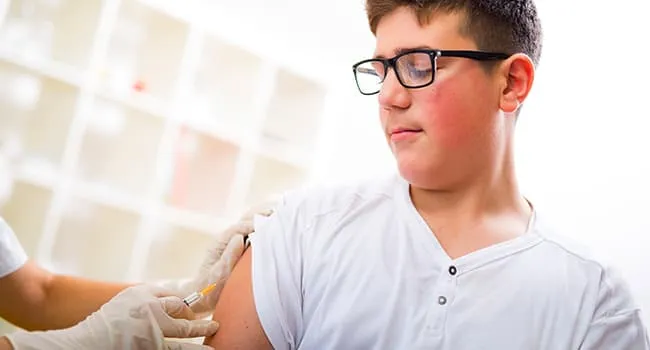

Too many U.S. children and teens are not getting their full roster of vaccinations, says H. Cody Meissner, MD, director of pediatric infectious disease at Tufts Medical Center and a professor of pediatrics at Tufts University School of Medicine. Lack of information, socio-demographic disparities, and mistrust in science may all be reasons.
The HPV (human papillomavirus) vaccine is one example of this. “HPV vaccination rates have gone up a few percentage points this past year but are still discouragingly low,” Meissner says. “There are about 31,000 cases of HPV-associated cancers in men and women each year in the U.S. The current HPV vaccine protects against 90% of those infections.”
Meissner reminds parents the HPV vaccine is a series of three inoculations, but “if the first dose is given before the 15th birthday, a teenager only needs two doses,” he says. “If the first dose is given after the 15th birthday, three doses are needed.”
The CDC says that in 2017, only 48.6% of all U.S. adolescents were up to date on the HPV vaccine series, compared with 43.4% in 2016. A continuing trend is how the first HPV dose remains lower among teens living in nonmetropolitan areas, at 59.3%, compared with teens living in cities, at 70.1%.
Meissner is also concerned about parents skipping the MMR (measles, mumps, rubella) vaccine. “We’re seeing clusters of measles in pockets of the country where people are not vaccinating their children,” he says. “It’s disturbing and unfortunate, because we’d beaten measles. Now, it’s coming back. People don’t understand that the measles virus is still around. It will find people who are susceptible, and measles can kill. The CDC reports that in the first two months of 2019, we’ve already had as many measles cases as we did in all of 2018. Rates are definitely going up.”
The flu is another concern. Only half of all Americans, and about only one-third of adolescents, get an annual flu shot. Several flu strains may circulate among the population each flu season, and these strains often change from year to year.
Scientists can’t yet produce a universal influenza vaccination that is highly effective against all strains. But don’t use that as a reason not to immunize your teen — or yourself or other family members, says Meissner. “Even if it’s only 30% effective, that’s 30% better than nothing,” he says. “Experience indicates that a breakthrough infection occurring after vaccination is likely to be less severe in a vaccinated individual than among individuals who were not vaccinated at all.”
In addition to an annual flu shot for all people, young and old, Meissner shares the following 2019 updates on vaccinations for children and teens.
- Hepatitis A: The CDC now recommends that infants ages 6 through 11 months be vaccinated if they are traveling internationally. Also, more and more, homelessness is making hepatitis A more likely due to unsanitary living conditions in which clean water may not always be available.
- Influenza and egg allergy: Meissner says the CDC has clarified that egg allergy is no longer considered a reason to avoid the flu vaccine. The amount of egg protein in the vaccine is so low that an allergic reaction is extremely unlikely.
- Meningococcal: All 11- to 12-year-olds should get one shot of meningococcal conjugate (MenACWY). A booster shot is recommended at age 16. Teens 16 to 18 years old may be vaccinated with a serogroup B meningococcal (MenB) vaccine.
- Booster shots: If there is a cluster outbreak of measles, mumps, or meningococcal disease in your town, state, or college campus, Meissner advises speaking with your health care provider, who should confer with the state health department to determine if booster vaccinations are needed.
Find more articles, browse back issues, and read the current issue of WebMD Magazine.






![How To Drive More Conversions With Fewer Clicks [MozCon 2025 Speaker Series] How To Drive More Conversions With Fewer Clicks [MozCon 2025 Speaker Series]](https://moz.com/images/blog/Blog-OG-images/Mozcon2025_Speaker-OGimage_1600x900_RebeccaJackson_London.png?w=1200&h=630&q=82&auto=format&fit=clip&dm=1750097490&s=d957426623f77c03dec4a2520d5e9844)